US Beverage Packaging Market Size
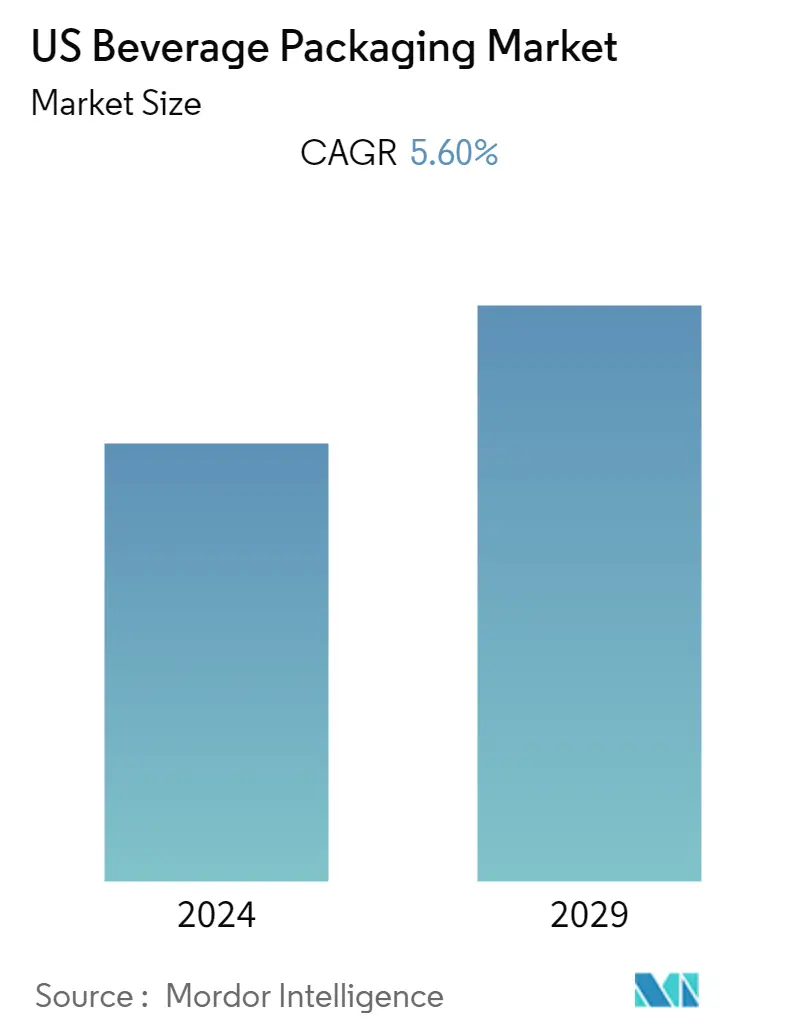
| Study Period | 2019 - 2029 |
| Base Year For Estimation | 2023 |
| Forecast Data Period | 2024 - 2029 |
| Historical Data Period | 2019 - 2022 |
| CAGR | 5.60 % |
| Market Concentration | Medium |
Major Players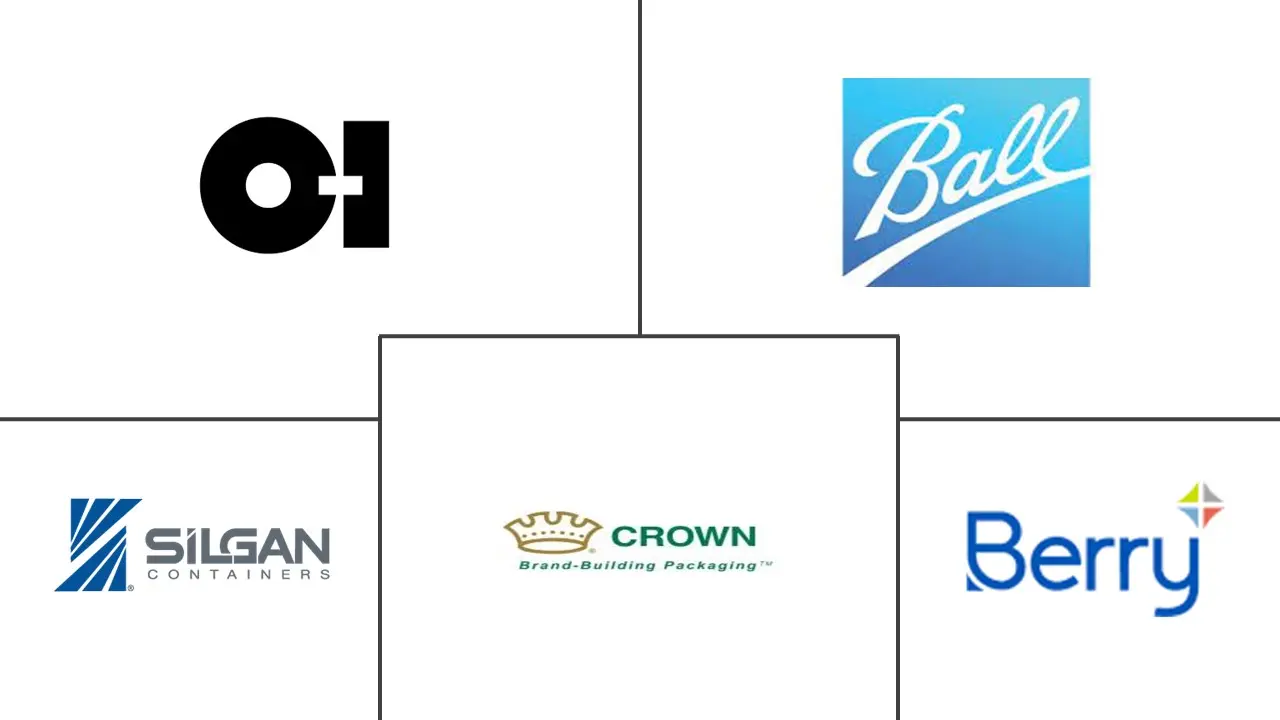
*Disclaimer: Major Players sorted in no particular order |
US Beverage Packaging Market Analysis
Packaging, as a critical factor, plays an essential role in the widespread consumption of beverages. The US beverage packaging market is estimated to grow at a CAGR of about 5.6% over the forecast period 2021 - 2026. Different beverages being packaged in varied materials and sizes reflect upon the sheer size of the market. Also, being a consumer-end market, the demand for the same has been rising significantly. Major drivers for the same have been growing disposable income, urbanization, and changing lifestyles.
- The growing demand for carbonated drinks, energy drinks, and juices, among others, is indicative of rising PET bottles and metal cans as preferred materials for the same. Glass, on the other hand, with its recyclable properties, has been challenged by increased costs of production and recycling. The preference for the same has been growing recently concerning sustainability trends across beverage packaging.
- Moreover, as plastic has been a long-standing and preferred packaging option by global beverage manufacturers, due to the reduced manufacturing, durability, and logistics costs, the transition towards sustainable packaging has driven these packaging manufacturers and bottling companies to pledge and commit usage of newer materials for the same.
- The American Beverage Association, amongst multiple soft drink producers in the region, announced a USD 100 million joint investment to drive PET bottle recycling in the United States and reduce the industry's use of virgin plastic. Similar trends across multiple regions and countries have been suggestive of a landscape influencing bottlers and packaging manufacturers to pivot product development strategies.
- For instance, as of February 2020, Ball Corporation is expected to expand the United States Metal Can production by 2021. Its specialty beverage can would commence operations in Arizona and the northeastern US, in line with the company's previous commitment to add at least 8 billion units of capacity by the end of 2021.
- Due to COVID-19 impact on the recycling front, multiple waste companies have been observed to have stopped or reduced recycling and collection processes. In the United States, Waste Management suspended operations at some of its materials recovery facilities (MRFs).
US Beverage Packaging Market Trends
This section covers the major market trends shaping the US Beverage Packaging Market according to our research experts:
Alcohol Beverages to hold significant market share
The categorization of alcoholic beverages includes wine, beer, spirits, etc., being packaged using formats such as bottles, kegs, cartons, and cans, to name a few.
- When it comes to Alcoholic beverages, there has been a significant transitioning of the wine industry concerning packaging format has been observed, as the global consumption across still wine has been slowing down. This has led the Unites States-based wineries to drive packaging innovations to cut costs and appeal to younger consumers.
- On the other hand, Beer's packaging is highly diverse; the formats packaging type preference has been driven by different regions where local laws, regulations, tastes, culture, and other drivers influence the packaging landscape.
- The draft beer sales stopped flowing in the United States due to on-premise shutdowns caused by efforts in the wake of novel coronavirus disease COVID-19. Therefore, allied craft brewers turned to 32 oz. Cans filled and sealed on demand to sell out leftover beer in kegs before oxidization. This has led to an increased demand for packaging towards current production in hand. Amidst the lockdown scenarios, packaging manufacturers have themselves reported operability with a reduced workforce, creating a supply-driven challenge.
- Changes in packaging materials, smaller sizes, and sustainability have all contributed significantly to changes in packaging development. Canned and boxed spirits are still in development as new forms of alcoholic beverages face challenges such as consumer acceptance, shelf life constraints, and lack of canning partners.
- Alcohol companies are adopting green production methods as when it comes to carbon footprint creation, the largest contribution of CO2 actually comes from the production and transportation of vials. In fact, these two components of the supply chain can account for 51% to 68% of a wine product's carbon footprint.
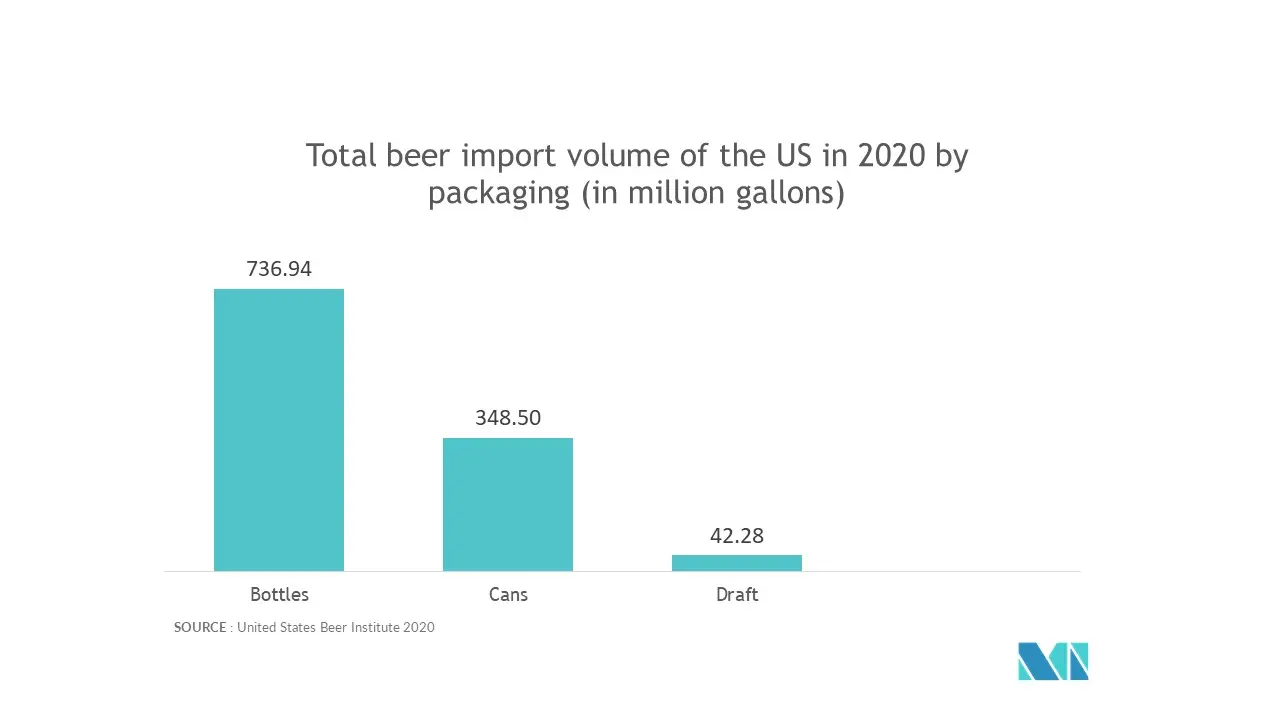
Metal Packaging holds high demand in beverages
Beverages demand home consumption, and grocery is increased compared to restaurants. Many prominent market players have announced investments to set up new manufacturing infrastructures to fulfill the increased demand.
- One of the biggest benefits of metal packaging is that they are highly recyclable. Metal packaging can be recycled at the end of their lifecycle without its quality degradation, and which makes metal packaging the preferred packaging type for brands across various beverage companies, ahead of other materials, such as plastic and bottle. Nearly 100% of the aluminum used in the cans can be melted down and used again.
- Further, the United States is witnessing several new aluminum can production facilities catering to various beverage needs in the country. For instance, in September 2021, Canpack, a can manufacturer, began constructing a new aluminum can factory in eastern Indiana and is expected to produce approximately 3.6 billion cans per year. The Canpack is a subsidiary of the Polish company Giorgi Global and the factory is expected to employ approximately 340 people in the long run.
- The Aluminum Association, Washington stated that plastic contamination in the recycling stream is driven mainly by increased use of plastic labels, shrink sleeves, and similar products, which can cause operational and even safety issues for recyclers. In September 2020, the Aluminum Association released an aluminum container design guide to further address some of these challenges and recommend solutions to beverage companies. Such solutions to address the challenges and instances of replacing plastic and glass drive the demand for aluminum cans in the market.
- Further, the average aluminum can produced in the United States contains approximately 73% recycled content, compared to 23% for glass bottles and less than 6% for plastic. Furthermore, aluminum can scrap more beneficial than glass or plastic, making aluminum a vital driver of the financial viability of the United States' recycling system.
- However, as people become more aware of the environmental impact of plastic, they are increasingly opting to buy beverages in cans rather than bottles. Additionally, Budweiser -an American beer company, started packaging icons to showcase its commitment to sustainability. The new 100% Renewable Energy logo on Budweiser packaging is a way for the brand to tell consumers the beer is made in breweries powered by renewable energy.
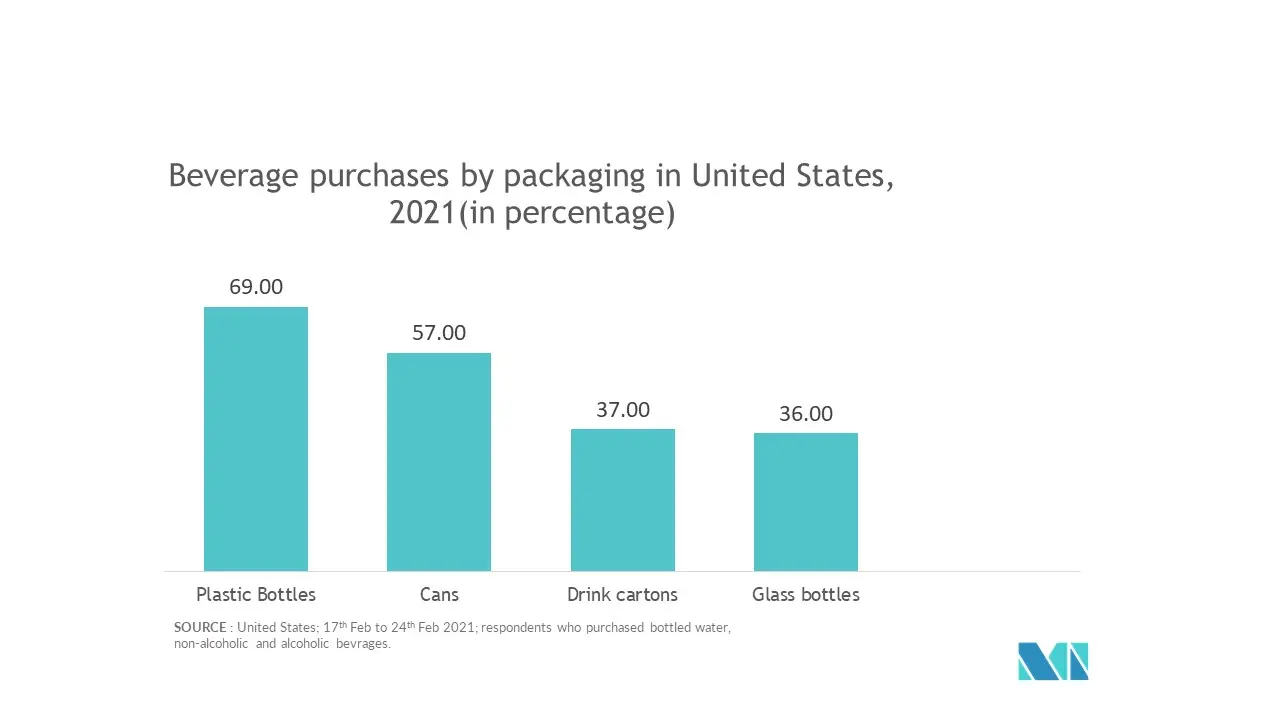
US Beverage Packaging Industry Overview
The United States Beverage Packaging Market is fragmented with the presence of key players such as Owens-Illinois Inc, Ball Corporation, Cronw Holdings Inc, Berry Global Inc., and Sonoco Products Compnay. These players are investing in R&D for new product innovations of packaging in the United States.
- March 2021 - Owens-illinois Inc announced an expansion in Andean Market to serve a sustainable market in glass packaging. The company invested approximately USD 75 million in an expansion at its Zipaquirá, Colombia facility. Upon completion by the end of 2022, the project is expected to add nearly 2 percent of capacity to the company's Americas segment and produce about 500 million bottles annually.
- September 2021 - Ball Corporation announced plans to build a new U.S. aluminum beverage packaging plant in North Las Vegas, Nevada. The multi-line plant is scheduled to begin production in late 2022 and is expected to create nearly 180 manufacturing jobs when fully operational.
- October 2021 - Crown Holdings, Inc. announced a collaboration with Velox Ltd. Crown and Velox brought together their expertise to unlock new possibilities for major brands wishing to increase product offerings, as well as smaller producers are taking advantage of the benefits of fully recyclable beverage cans. The technology and solution deliver market firsts and create greater brand design options with running speeds over five times faster than existing digital solutions
US Beverage Packaging Market Leaders
-
Owens-Illinois Inc.
-
Ball Corporation
-
Crown Holdings Inc.
-
Silgan Containers LLC
-
Berry Global Inc.
*Disclaimer: Major Players sorted in no particular order
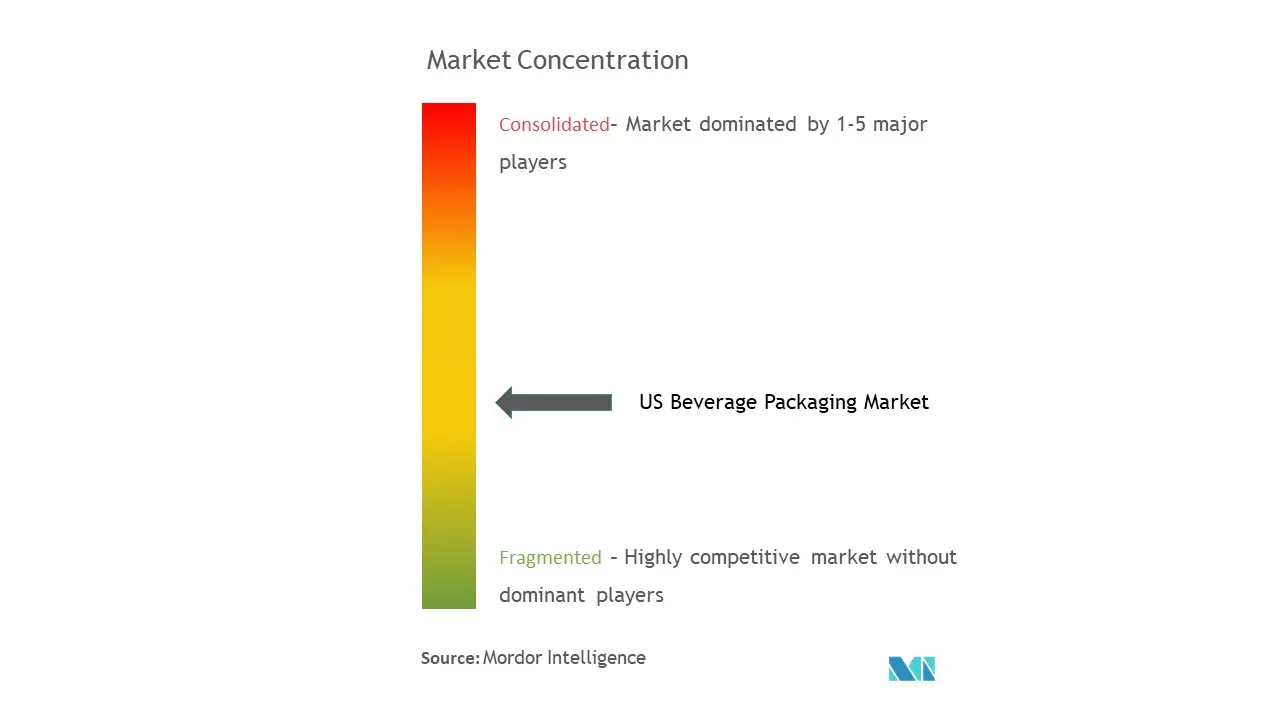
US Beverage Packaging Market News
- July 2021 - Ball Corporation is planning to significantly increase its manufacturing capacity, with new cutting-edge facilities in the UK and Russia. With an increasing consumer call for more sustainable purchasing options and a growing number of new brands and beverage categories choosing cans, demand for aluminum packaging is rapidly expanding around the world.
- September 2021 - Crown Holdings Inc. announced Southwestern United States aluminum beverage could manufacturing facility will be located in Mesquite, Nevada. This two-line state-of-the-art plant will supply standard and specialty beverage cans to the Company's customers serving a variety of categories, including carbonated soft drinks, sparkling water, energy drinks, hard seltzers, beer, and ready-to-drink cocktails.
US Beverage Packaging Market Report - Table of Contents
1. INTRODUCTION
- 1.1 Study Assumptions and Market Definition
- 1.2 Scope of the Study
2. RESEARCH METHODOLOGY
3. EXECUTIVE SUMMARY
4. MARKET INSIGHTS
- 4.1 Market Overview
- 4.2 Value Chain / Supply Chain Analysis
-
4.3 Porters 5 Force Analysis
- 4.3.1 Threat of New Entrants
- 4.3.2 Bargaining Power of Buyers
- 4.3.3 Bargaining Power of Suppliers
- 4.3.4 Threat of Substitute Products
- 4.3.5 Intensity of Competitive Rivalry
- 4.4 Assessment of the Impact of COVID-19 on the Market
5. Market Dynamics
- 5.1 Market Drivers
- 5.2 Market Restraints
6. MARKET SEGMENTATION
-
6.1 By Material
- 6.1.1 Plastic
- 6.1.2 Metal
- 6.1.3 Glass
- 6.1.4 Paperboard
-
6.2 By Product Type
- 6.2.1 Bottles
- 6.2.2 Cans
- 6.2.3 Pouches
- 6.2.4 Cartons
- 6.2.5 Beer kegs
-
6.3 By Application
- 6.3.1 Alcoholic Beverages
- 6.3.2 Milk
- 6.3.3 Energy Drinks
- 6.3.4 Other applications
7. COMPETITIVE LANDSCAPE
-
7.1 Company Profiles
- 7.1.1 Owens-illinois Inc.
- 7.1.2 Ball Corporation
- 7.1.3 Crown Holdings Inc.
- 7.1.4 Silgan Containers Inc.
- 7.1.5 Berry Global Inc.
- 7.1.6 Sonoco Products Company
- 7.1.7 CCL Containers Inc
- 7.1.8 Ardagh Group
- 7.1.9 Amcor Limited
- 7.1.10 Berlin Packaging
- 7.1.11 Westrock
- *List Not Exhaustive
8. Investment Analysis
9. Future of the Market
** Subject To AvailablityUS Beverage Packaging Industry Segmentation
The United States beverage packaging market studies the market segmentation based on different materials, like paper, plastic, glass, and metal. The market study focuses on various aspects, such as sustainability, production rate in beverage products, supply and demand, and the impact of COVID-19 on the market.
US Beverage Packaging Market Research FAQs
What is the current US Beverage Packaging Market size?
The US Beverage Packaging Market is projected to register a CAGR of 5.60% during the forecast period (2024-2029)
Who are the key players in US Beverage Packaging Market?
Owens-Illinois Inc., Ball Corporation , Crown Holdings Inc., Silgan Containers LLC and Berry Global Inc. are the major companies operating in the US Beverage Packaging Market.
What years does this US Beverage Packaging Market cover?
The report covers the US Beverage Packaging Market historical market size for years: 2019, 2020, 2021, 2022 and 2023. The report also forecasts the US Beverage Packaging Market size for years: 2024, 2025, 2026, 2027, 2028 and 2029.
US Beverage Packaging Industry Report
Statistics for the 2024 US Beverage Packaging market share, size and revenue growth rate, created by Mordor Intelligence™ Industry Reports. US Beverage Packaging analysis includes a market forecast outlook 2029 and historical overview. Get a sample of this industry analysis as a free report PDF download.



